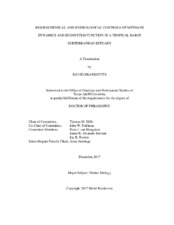| dc.contributor.advisor | Iliffe, Thomas M. | |
| dc.contributor.advisor | Pohlman, John W. | |
| dc.creator | Brankovits, David | |
| dc.date.accessioned | 2019-01-16T20:40:28Z | |
| dc.date.available | 2019-12-01T06:36:08Z | |
| dc.date.created | 2017-12 | |
| dc.date.issued | 2017-11-14 | |
| dc.date.submitted | December 2017 | |
| dc.identifier.uri | https://hdl.handle.net/1969.1/173156 | |
| dc.description.abstract | Subterranean estuaries extend into carbonate platforms where extensive cave networks influence the hydrology and biogeochemistry of the coastal aquifer. How complex biological communities thrive in this globally-distributed, cryptic ecosystem (termed anchialine) is poorly understood. This dissertation explores the role of dissolved organic carbon, with an emphasis on methane, in the carbon cycling and ecosystem function of a tropical karst subterranean estuary in the Yucatan Peninsula, Mexico. The first study presents evidence for a microbial loop that shuttles methane and other dissolved organic carbon compounds to higher trophic levels of the food web. Methane and dissolved organic carbon production and consumption within the coastal groundwater correspond with a microbial community capable of methanotrophy, heterotrophy and chemoautotrophy, based on characterization by 16S rRNA amplicon sequencing and respiratory quinone composition. Fatty acid and bulk stable carbon isotope values of cave-adapted shrimp suggest that methane-derived carbon obtained through consumption of methanotrophic bacteria comprises, on average, 21% (ranging 0-55%) of their diet. The next study identifies a biogeochemical hotspot associated with a sharp (95% of methane in the caves. Finally, a time-series analysis of chemical constituents and physical parameters reveals that precipitation-induced hydrologic changes affect the distribution and oxidation of methane in the caves. Between 21 and 28 mg CH₄ m⁻² yr⁻¹ are consumed during the dry season within the drainage basin of the studied subterranean estuary. Overall, findings from this dissertation provide multiple pieces of evidence for a previously unaccounted for methane sink that provides carbon and energy for an anchialine ecosystem. | en |
| dc.format.mimetype | application/pdf | |
| dc.language.iso | en | |
| dc.subject | methane | en |
| dc.subject | anchialine | en |
| dc.subject | biogeochemistry | en |
| dc.subject | ecosystem function | en |
| dc.subject | stable carbon isotope | en |
| dc.subject | estuary | en |
| dc.subject | cave | en |
| dc.title | Biogeochemical and Hydrological Controls of Methane Dynamics and Ecosystem Function in a Tropical Karst Subterranean Estuary | en |
| dc.type | Thesis | en |
| thesis.degree.department | Marine Biology | en |
| thesis.degree.discipline | Marine Biology | en |
| thesis.degree.grantor | Texas A & M University | en |
| thesis.degree.name | Doctor of Philosophy | en |
| thesis.degree.level | Doctoral | en |
| dc.contributor.committeeMember | van Hengstum, Peter J. | |
| dc.contributor.committeeMember | Rooker, Jay R. | |
| dc.contributor.committeeMember | Alvarado-Bremer, Jaime R. | |
| dc.type.material | text | en |
| dc.date.updated | 2019-01-16T20:40:28Z | |
| local.embargo.terms | 2019-12-01 | |
| local.etdauthor.orcid | 0000-0001-9195-8115 | |


